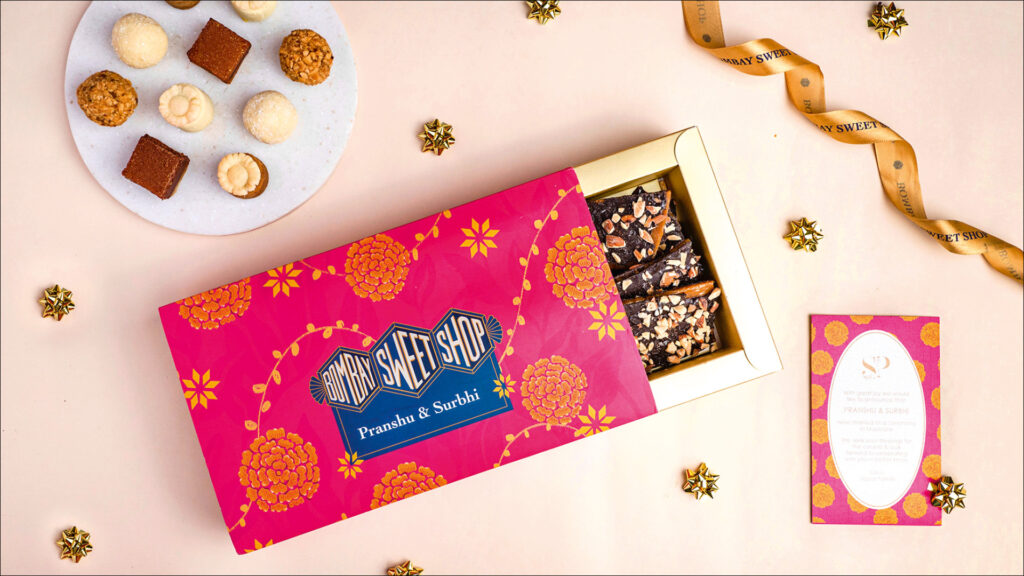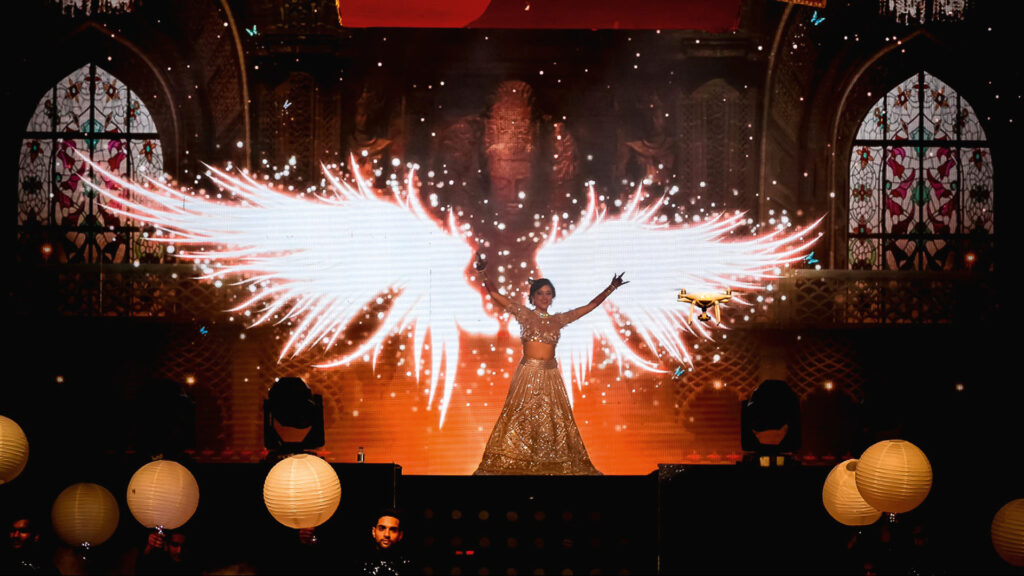As the wedding season takes off post the pandemic-driven hiatus, we explore the new trends making these special affairs smarter, slicker, and more personalised than
ever before.
By ANUBHUTI KRISHNA

“We have seen a revival in the wedding segment, with demand surpassing pre-COVID levels from the third quarter onwards for this fiscal year! Our network of hotels positions us well to meet this demand,” says Parveen Chander Kumar, Executive Vice President, Sales and Marketing, IHCL,
the parent company for Taj Hotels, known for their expansive wedding portfolio. The sentiment is shared by everyone in the wedding industry
as this profitable segment picks up after a long, sluggish period.
According to a report released by the Confederation of All India Traders in November 2022, India is scheduled to witness 32 lakh weddings between 4 November and 14 December 2022, where an estimated ₹3.75 lakh crore is expected to be pumped into the market. Another report, published in The Mint in September, says the wedding industry is looking at a 200 per cent growth post the pandemic slump.
While promising, this still leaves much scope for growth given that
a 2016 KPMG report titled ‘Market Study of Online Matrimony and Marriage Services in India’ had estimated that the Indian wedding industry is worth about ₹3.68 trillion with an annual growth of 25
to 30 per cent! The segment, largely considered recession free, suffered a huge setback in 2020 and 2021, but seems well on its way to recovery and the industry is looking at the peak season with hope. We speak to experts across the wedding industry to look at some of the top trends driving the festive occasion.
IT’S ALL ABOUT THE DESTINATION

Deprived of travel for the past two years, Indians are venturing out with renewed vigour! And the demand for destination weddings is
at an all-time high. While budget-friendly countries in the Middle East and Southeast Asia find favour with the middle-class, new and novel destinations are exciting the HNIs (High Net-worth Individuals). An Indian wedding in Monaco recently drew eyeballs for cordoning off
the city square for the baraat (wedding procession), while another in Florence was all over social media for recreating the Parisian nightlife of the 1900s.
“With the world opening up, people are going all out in terms of numbers, scale, and budgets, and are accommodating everything else to get married at their favourite destinations,” informs Tina Tharwani, co-founder of Shaadi Squad, a boutique wedding planning firm. According to Tharwani, the budget for these weddings can be anywhere upwards of ₹1 crore; this year, however, it is expected to rise by 20 per cent given the increasing cost of travel and stay.

In India, the palaces in Rajasthan, beach resorts in Kerala and Goa, and luxury hotels across cities continue to draw weddings of all sizes. IHCL’s ‘Timeless Weddings’ programme has seen a significant surge in destination weddings across Taj’s palaces, resorts, and city hotels, with banquet and outdoor spaces booked out for the season. The company has witnessed a growth of almost 48 per cent in H1 of 2022 in the wedding segment. According to a report published in Business Standard in November 2022, tariffs are up by a record 25 to 30 per cent over 2019-20 levels, and hotels across the country are booked out from October onwards.

The renewed desire for destination weddings is also marked by an uptick in eco-friendly nuptials. According to a 2022 survey by The Knot, a US-based wedding planning company, 70 per cent of the couples interviewed stated that if they get married in 2022, they would opt for eco-friendly elements. “Grape County, a luxury eco-resort, is all about sustainability. We think weddings can be extravagant while still being environmentally conscious. We can now use green materials for everything, from invitations to cuisines and décor,” says Tejas Chavan, Managing Director, Green Spaces, the parent company of Grape County.
THE PERSONAL TOUCH

Indian weddings have traditionally always been big affairs, with multi-event ceremonies extending across several nights and multiple venues. After a brief hiatus, this tradition is back but with a twist: Curated, bespoke experiences are on everyone’s wish list now. “There is a distinctive demand for intimate and personalised celebrations. Even with larger-than-life weddings, our clients are opting for high-end celebratory affairs, albeit with a select number of guests,” says Nayan Seth, General Manager, Taj Palace, New Delhi. According to Shivan Gupta, founder of Amaara Farms, a luxurious open space that hosts a large number of high-end weddings in the capital, the average size of a wedding is not expected to go beyond 500 guests this season. Until
a few years ago, this number stood between 1,000 to 1,200. “The intention,” adds Shivan, “is to make guest experiences more meaningful and not reduce cost.”
The desire for a ‘different’ wedding extends to fashion, too. Couples want coordinated looks for each event and are happy to allot a large chunk of the budget to clothes and jewellery. As Maninder Sethi, founder of Wedding Asia, a wedding-services platform, puts it, “While today’s bride knows what she wants, the grooms also have distinct demands for couture and jewellery.” According to designer Ashdeen Lilaowala, personalisation can range from creating a motif that signifies something special to the couple to including verses and poems on the bride and groom’s wedding ensemble.
DELECTABLE TASTES
Couples, today, are increasingly prioritising well-crafted culinary experiences for their guests. The demand for large spreads is declining and most people are looking at menus that are exciting, as well as wholesome. “The fascination with mile-long buffet tables has seen a dip. Clients now want smaller, more specialised menus,” informs Chef Ritu Dalmia, who caters some of the biggest weddings in India.

Gifting Indian food items is also a large part of all related events. “We have seen a huge surge in the demand for our chocolate, mithai, and gift boxes in the past one month—from announcements and engagements to weddings and send-off gifts, people are opting for premium confectionary brands that resonate with them,” says Yash Bhanage, founder and COO of Bombay Sweet Shop. Their gifting sale currently stands at 20 per cent of total revenues and is expected
to rise.
AESTHETICALLY TECHNICAL

Yet another segment that has become intensely bespoke is décor. Tech-décor involving LED tunnels, dynamic lights, interactive sets, and 3D mapping are the rage in larger venues. While subtle and elegant floral décor is preferred in indoor weddings. “The trend now is to have the space designed to match the overall design aesthetic of your wedding function, with each venue and every event being distinct from each other,” says Anuja Joshi, co-founder and CEO Interflora. “The décor market accounts for about 30 per cent of the wedding budget; of this 10 per cent is allocated just to floral décor. If we consider the aforementioned figures by KPMG, the floral decoration alone stands at ₹11,000 crore! And this year, it is expected to grow manifold.”

Of course, the modern-day soirée is incomplete without entertainment. And the latest in this segment is ‘Wed-Tech’. Artists from across the world are now performing at Indian weddings, and everything from the sangeet to the jaimaala (garland exchange) is tech-enabled. “Our acts are smarter, shorter, and choreographed with kinetic lights, musical-beat mapping, holographic and laser acts… the list goes on,” informs Srishti Arya, founder of Happy Dancing Feet, a luxury wedding choreography company.
Whatever be the case, one thing is clear: customers will continue to demand better, more innovative solutions from service providers, and the Indian wedding business will continue to thrive, despite all odds.
Related: Explore The Reason Behind India’s Successful Art Market



